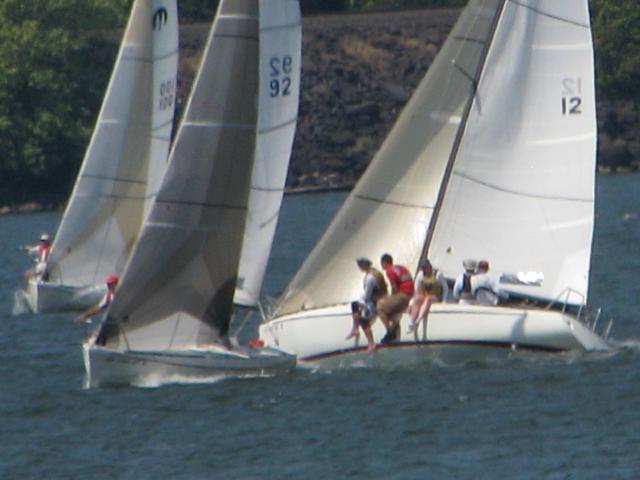Mast
The following guidelines are to be used as a reference, masts and sails may differ but this is still of value. Do not hesitate to experiment, as differences in crew weight and conditions will require a certain setting for optimum performance. The mast must be straight athwartship at all time. When starting to tune your rig open forestay turnbuckle to class maximum 28'-6". Rake of mast (backstay tension) is set at 30'-7.5" from main halyard shackle pin (2-3/4" from top of nicro press to shackle pin), pulled tight at masthead to transom corner. Measure this with backstay tensioned to just before mast bends.
Upper Shrouds
Make sure masthead is over centerline of boat with uppers snug. Using a metal tape measure attached to the main halyard raise halyard to masthead and measure on Port and Starboard (P & S) to turnbuckle pin making sure P & S measurement is the same. Tighten uppers uniformly checking occasionally to see if mast is till in center of boat. They should be tight enough so that while sailing 10 to 15 knots masthead should not fall to leeward enough to slacken leeward upper.
Lower Intermediate Shrouds
Looking up the mast mainsail groove tighten uniformly until mast is straight. Use slightly less tension than uppers. It is important to realize that the intermediates are setup so the the mast remains straight in all conditions.
Aft Lowers
The aft lowers are used as a mainsail shaping device. It is basically set quite tight. This power ups the main and allows a bit of backstay to be used without flattening the main. This results in a straight headstay and a powerful main and therefore maximum speed and pointing ability. Aft lowers should be set up according to the luff curve of the main (mainsail specifications)..i.e. Full main- (less [more - flc]luff curve), less tension on aft lowers. Flat main- (less luff curve), more tension on aft lowers. Your sailmaker should be able to assist you with tuning as required. Headstay sag is affected by aft lower tension. Draft at about 40%. As the wind increases the aft lowers can be eased slightly which will depower the main by flattening it and opening the mid-leach. This will ease the helm and heel angle. Two turns can make a large difference.
Mainsail Trim
The main is cut to be trimmed with a fairly straight leach. However, light air requires more twist and vice versa. In moderate to heavy air the traveler should be played constantly to keep the boat as flat as possible. The combination of traveler playing to steering is critical to upwind speed. Excellent coordination is needed between helmsman and crew on the traveler. The backstay in conjunction with the aft lower shroud controls the amount and shape of mast bend and therefore the fullness of the main. More backstay means a flatter sail and vice versa. Basically, begin to flatten as the boat becomes difficult to keep flat. The outhaul affects only the lower third of the sail and should be increasingly tightened as the wind increases. The cunningham is used to keep the draft in the proper position (i.e. 40-45% aft). Do not over-tighten it in light to moderate air. If you get diagonal wrinkles out of the mast toward the clew, increased cunningham (or tighter aft lowers) can correct this problem. You may want to carry some overband wrinkles in very heavy winds.
Headsails
All of the headsails are cut to have the headstay as straight as possible in all except very sloppy conditions. The 150% headsail should be used as long as possible (i.e. to about 18 knots for an 825lb. crew). It is very important to keep the boat flat, so headsail size should be decreased as necessary. The exact wind range and sail size will vary depending on crew weight. For a crew of approximately 825lbs. the following is recommended:
| 150% | 0-18 knots apparent |
| 115% | 18-23 knots |
| 90% | 23+ knots |
| 150% | 13-18 knots- round entry for power, sheet outboard |
| 110% | to 25 knots |
| 85% | 25+ knots |
The cut of your sails will radically alter the above recommendations (i.e. a full sail will overpower sooner and your pointing ability will suffer compared to a sail with a flatter entry).
Notes: the 150 headsail should be moved to the outboard lead and then feathered before stepping down. All other headsails should normally lead to the rail unless the water smooth and you can keep the boat flat. Some boats (offered as an option on 1984 and later models), do not have inboard leads for the blades. Sailmakers recommend 7°-8° sheeting angle for small (85%-100%) jibs. You might have to install a 12" track inboard of shrouds.
General Instructions
Remember these are guidelines and exact trim will vary with conditions and crew ability. Use imagination subject to cut of sails, crew weight, seas, and wind velocity. If the boat is flat (15° heel-with a little weather helm) and responsive you're probably fast. If the boat feels sluggish but heel angle is correct you could be under powered. Try sheeting inboard before going up in headsail size.
We hope these suggestions will help you get the most from your sails and (have more fun) on your Moore 24.
Paul Sharp National Champion-1981 Ron MooreOwner of Moore Sailboats -- 1971-1985
*Class rule on headstay length maximum was disallowed by vote in January 1984. Some people rake their mast more to increase weather helm. Most people find 28'-6" to balance well and therefore a good starting point.

